Whatever the emotions you want to create, there will be certain colors, patterns and spacing techniques to achieve the desired effect.
You know that you want your rooms and home to convey certain feelings: relaxation in the bathroom, excitement in the dining room.
A great way of picking a theme is by finding an inspiration piece. Pictures, nature, even favorite articles of clothing can all be used to inspire your theme.
There are, in fact, so many different ways of bringing the elements of a room together to create a feeling that it can seem overwhelming to try to develop a cohesive look. One effective way of designing a room is to choose a theme to base the look on.
To select a theme for a room, first, evaluate the kind of feel you want the place to have.
A place designed to be soothing is probably not going to be well served by a theme like a neon jungle. You should also avoid having a theme that’s too narrow; having your child’s bedroom look exactly like Andy’s Room from Toy Story may seem novel at first, but like most novelty items the appeal will wear down over time.
Thematic rooms that are too tightly defined also leave little room for new items and any room should be able to grow and change in character as time passes.
Looking through other designs that incorporate the feeling or elements you want is a great way of getting inspired. You can also opt to use a permanent fixture as inspiration.
If you have some of the best quality quartz countertops, for example, you might design your theme around them as a focal point.
Your theme should be encompassed in a short phrase. Cozy temperate woodland or comfortable beach at midday could all be used to bring different colors, shapes, and items into the room.
These broad themes still allow you to incorporate new items into the room but are rigid enough to draw your mind to certain important elements.
Your room will almost always have a focal point, an area that immediately draws attention to itself. Focal points are often (but not always) in the middle, and are often (and again, not always) large compared to other items in the room.
Fireplaces, built-in bookshelves, and bay windows might all be focal points. Even an area rug that draws the eye could be a point of focus.
The focal point in your room should give you an idea as to the theme of the room immediately, as everything around it will be seen as somewhat complementary to the focal point itself.
Your theme will likely have a few dominant colors, patterns and shapes, so try to change things up a bit in order to add interest.
Vary the patterns, brightness, sheen, and saturation of the objects in the room in order to make it pop.






